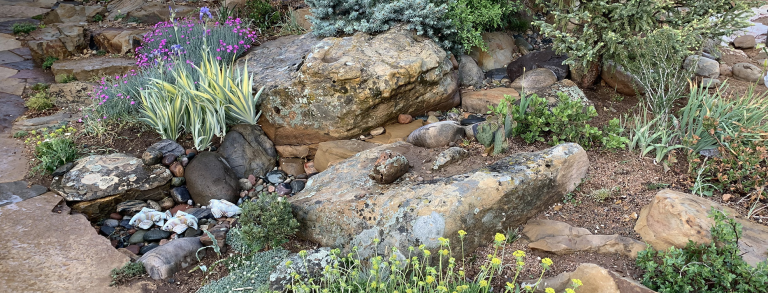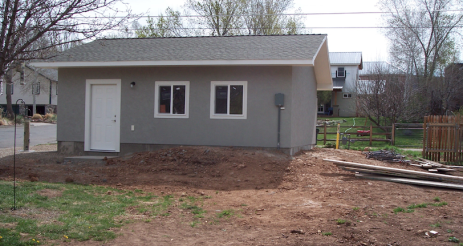To call it a “garage” would be an insult to outbuildings everywhere.
Constructed in the 1950s with two salvaged mismatched bay doors, this detached “garage” had dirt floors, no insulation, and a hole in the roof where someone obviously fell through. Inside, a lone light bulb offered all the charm of a Third World prison cell.
And those were the good points. Demolition consisted of one slight nudge from a backhoe.
A rock garden was born. Sort of.
The problem was soil. You see, the old atrocious garage, for reasons beyond comprehension, was built below grade. The sill plates had rotted from years of snow contact and pooling rainwater. The solution: bring in earth to elevate the site and create drainage away from the new structure.
Contractors are great folks. But most are not gardeners. To them, soil is what you build things on.
Thus, on a spring morning nine years ago, two dump trucks showed up and deposited the nastiest, stickiest, orange clay subsoil. By afternoon, heavy equipment busily compacted this pottery-grade fill.
The soil was so bad that nothing grew there in the first year except for some miserable strands of bindweed. Not only did the site lack tilth, it also lacked life, be it microbial or invertebrate.
This was a blessing in disguise because there were a few other pending gardening projects, namely flagstone paths, waterwise borders, woodland plantings, fences, a street-facing hellstrip, a southern-exposure crevice garden, a fish pond, two decks and the planting of 10,000 bulbs amongst buffalo grass lawn plugs.
But the clay barrens of Garage Hill were not completely ignored. In year two, my wife Amy and I hired a forklift to kerplunk a massive lichen boulder on the hillside. We softened its edges with a bristlecone pine (Pinus aristata), a mounding blue spruce (Picea pungens 'Globosa'), and a New Mexico privet (Foresteria neomexicana). At the boulder’s feet, firewitch dianthus (Dianthus ‘Feuerhexe’) and variegated iris (Iris pallida 'Variegata Gold') put on a gaudy show. A formidable amount of cotton burr compost was dug in to give these plants a fighting chance.
It was a garden. There was a rock. Not quite a rock garden, though. What was the answer? More rock! Another big one!
By now, there was no room for a forklift. So Amy and I went all Egyptian on that half-ton stone. We cut lengths of PVC pipe for rollers and used an iron digging bar as a lever to slide the beast across the driveway and yard and into place. A cheap hydraulic jack was deployed to raise the stone inch by inch, then blocked with scrap lumber. With enough height, the boulder slid down a dangerously janky ramp to its eventual resting spot. It was a miracle that OSHA inspectors were not called in.
So now there were two big nice-looking rocks, but neither of which solved the problem of poor soil.
In the War on Clay, leaves became my weapons of mass distraction, buying time for when something good could be done on a site with little going for it.
Where does one get enough leaves to smother 300 square feet (28 m2) of clay hillside? You steal them from the neighbors, of course.
Yes, I am the one who skulks the darkened streets of Durango, Colorado, during October’s chilled nights, snatching curbside bags of autumnal bounty. I spirited away deciduous detritus in a baby-blue getaway car, then dumped the goods on the clay.
Over the years, the leaves on Garage Hill broke down sufficiently to provide some structure and biological progress. Worms set up shop. The bindweed seemed happier. Some additional interlopers made a cameo, including a surge of jointed goat grass. But a few inches down, the soil was still heavy, nasty, orange, non-draining clay.
Then, on a partly cloudy May morning last year, the liberation of Garage Hill began in earnest, inspired by a present from Amy: she gave me a beefy dolly for moving heavy stuff.
She’s a terrific enabler.
The first order of business with any rock garden is, well, rocks. Here in Durango, we have lots of them, especially the tawny Cretaceous sandstone outcroppings that rim of the Animas River valley.
Along a former state highway south of town, flaked-off chunks are easy roadside pickings. Just like bags of leaves in fall, only a heck of a lot heavier.
A co-worker with a pickup and a strong back helped in a “strategic relocation project.” Three trips provided ample material.
Meanwhile, a friendly neighbor-landowner generously offered permission for us to scrounge his nearby abandoned quarry. It’s where masons cleaved stones used to construct many of the town’s frontier buildings.
But having a driveway filled with rocks doesn’t improve soil drainage. That’s where bags of expanded shale came in.
I hadn’t used expanded shale before. But seeing expanded shale used so successfully on Denver Botanic Gardens’ xeric demonstration green roof won me over. There, expanded shale comprises 80 percent of the roof’s growing medium, mixed with 10 percent compost and 10 percent mulch.
Expanded shale resembles rounded greyish gravel. It’s made by grinding natural shale and heating it to 2,000°F (1,093°C). The process creates tiny porous cavities in each piece. Not only does expanded shale aerate the soil, particularly clay, but each particle can also hold 40 percent of its weight in water to be released slowly over time. Also, expanded shale doesn’t break down.
Ten 40-pound (18 kg) bags of shale were spread five inches (13 cm) deep over the clay, then topped by a dusting of cotton burr compost and an inch-deep layer of Yum-Yum Mix 2-1-1 fertilizer. The amendments and shale were dug in a foot (30 cm) deep.
Then began the fun: rock placement, otherwise known as fingertip crushing.
The field-gathered tan and khaki rock chunks feature sharp edges and brown varnishing. Look closely, and you might even see some fossils. Other than being sandstone, these rocks had little in common with the two rounded and weather-worn lichen boulders. But, as they say, you dance with the one who brung ya.
After nine weekends of placing, tweaking, rebuilding, and cursing, it was far past time for planting something. Anything.
But which plants? It’s complicated. In addition to dubious dirt, half of Garage Hill is fronted by a sickly old cherry tree that casts late afternoon shadows all summer.
So here I had ideal conditions for planting a quality rock garden: crummy clay soil, rocks that don’t really match, and some shade. And it was late September at 6,512 feet (1985 m) in the southern Rocky Mountains.
Fortunately, Denver Botanic Gardens’ annual bulb and plant sale beckoned, and the 14-hour round-trip drive offered ample time to concoct delusional garden fantasies.
Recklessly and desperately, I snatched up any plant whose tag read “part shade,” along with the usual suspects for diminished sunlight: five varieties of miniature hostas, dwarf heuchera, and some mix-and-match lewisia hybrids. They survived the winter remarkably well despite the late installation and the fact that all plants were bare-rooted when put in the ground.
Argentinian “plastic plant” Bolax gummifera and European dwarf lady’s mantle seem thrilled with their ex-pat high-desert digs.
Draba aizoides and D. rigida var. bryoides bloomed then promptly died. However, the Achillea x kellereri appears unfazed, as does dark Jovibarba heuffelii ‘Gold Bug’ and the Plant Select petite Geranium dalmaticum.
Acantholimon litvinovii seems happy so far. Not so for Andryala agardhii and some other drylanders, even with vastly improved drainage and a location in a sunnier spot.
Native and rare Packera mancosana, meanwhile, thrives in a special bed with extra shale. In the wild, this Asteraceae grows in cracks of gray Mancos shale barrens. Discovered in 2008 and endemic only to one spot in neighboring Dolores County, seed-grown specimens were offered at the Denver Botanic Gardens' sale. I was smitten. It’s a thrill and honor to repatriate a dozen back to Southwest Colorado.
On the other hand, don’t get me started on daphnes. This has got to be the tenth one I’ve killed, despite having a flawless shady nook, perfectly drained soil and a mild winter. Short of a goat sacrifice, I don’t know what else to do to successfully grow these expensive fussbudgets.
Not all the crevices and crannies are filled with perennials. A couple of slow-growing western native shrubs were installed. Transplanted from four-inch (10 cm) pots, waxflower (Jamesia americana) and littleleaf mountain mahogany (Cercocarpus intricatus) will take years to outgrow the space.
The exact opposite is hoped for with a bluestem joint fir (Ephedra equisetina). Planted under the parched rain-shadowed eaves, this sprawling Mongolian gymnosperm will provide an easily pruned turquoise backdrop for tan blocks of Southwestern sandstone. In ten years, someone will say, “See, I told you not to plant a xeric shrub that suckers.” But that’s a decade out.
Being a bulb aficionado, I couldn’t resist rock-pocket showcases for some favorite small bulbs: white-capped Muscari aucheri, impossibly deep-red Tulipa wilsoniana, the beguiling dagger-petaled Tulipa acuminata and a clump of bi-colored Tulipa clusiana.
So, is expanded shale the miracle medium? It’s too early to say for sure. But there’s no way the existing clay subsoil would have accommodated much of anything. Garage Hill was nine years in the making. No doubt it will take another nine years to see if it works. Until then, it’s going to be a project governed by trowel and error.


